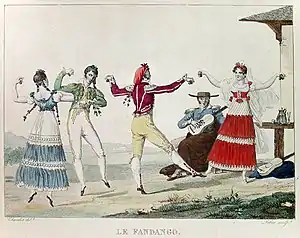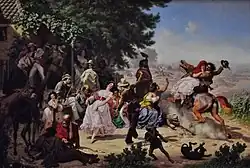Fandango
Fandango is a lively partner dance originating in Portugal and Spain, usually in triple meter, traditionally accompanied by guitars, castanets, tambourine or hand-clapping. Fandango can both be sung and danced. Sung fandango is usually bipartite: it has an instrumental introduction followed by "variaciones". Sung fandango usually follows the structure of "cante" that consist of four or five octosyllabic verses (coplas) or musical phrases (tercios). Occasionally, the first copla is repeated.

The meter of fandango is similar to that of the bolero and seguidilla. It was originally notated in 6
8 time, of slow tempo, mostly in the minor, with a trio in the major; sometimes, however, the whole was in a major key. Later it took the 3-4 tempo, and the characteristic Spanish rhythm.[2]
Origins
The earliest fandango melody is found in the anonymous "Libro de diferentes cifras de guitarra" from 1705, and the earliest description of the dance itself is found in a 1712 letter by Martín Martí, a Spanish priest. The fandango's first sighting in a theatrical work was in Francisco de Leefadeal's entremés "El novio de la aldeana" staged in Seville, ca. 1720. By the late 18th century it had become fashionable among the aristocracy and was often included in tonadillas, zarzuelas, ballets and operas, not only in Spain, but also elsewhere in Europe.[3][4]
Widely varying claims have been made about the origin of fandango: its relation to the soleá, jabera and petenera; to the Andalusian malagueña, granadina, murciana and rondeña; to the canario and gitano; to the jota aragonesa.[5]
Condemnation and liberation by Spanish Church
There is a curious piece of history said to be connected with this dance. Soon after its first introduction, in the 17th century, it was condemned by the ecclesiastical authorities in Spain as a "godless dance". Just as the Consistory were about to prohibit it, one of the judges remarked that it was not fair to condemn anyone unheard. Two celebrated dancers were accordingly introduced to perform the fandango before the Consistory. This they did with such effect, that, according to the old chronicler, "every one joined in, and the hall of the consistorium was turned into a dancing saloon". No more was heard of the condemnation of the fandango.[2]
Classical music
The form of fandango has been used by many European composers, and often included in stage and instrumental works. Notable examples include J. P. Rameau's "Les trois mains" (in "Nouvelles suites de pièces de clavecin", ca. 1729–30); Fandango forms #19 in the part 2 of Gluck's ballet Don Juan (1761); in the third-act finale of Mozart's opera The Marriage of Figaro (1786); in the finale of Luigi Boccherini's String Quartet Op. 40 No. 2 (1798)[2] and Guitar Quintet G.448; Antonio Soler's Fandango for harpsichord; and the finale of Rimsky-Korsakov's Capriccio Espagnol. Luis de Freitas Branco's third movement of his "Suite Alentejana No. 1" is inspired on the fandango of the regions of Alentejo and Ribatejo of Portugal.
Italian composer Domenico Scarlatti, who was influenced by Iberian folk music, had several passages reminiscents of fandango, such as in his keyboard sonata K. 492 (1756) which has been called "Fandango portugués".[6] The piece "Fandango del Sigr. Escarlate" has been attributed to him, but some scholars dispute this claim and its similarity to fandangos.[6]
The Spanish form of fandango is given by Dohrn in the Neue Zeitschrift f. Music.[7]
Spanish dance
The current 3
4 pattern of the fandango, its distinctive progression (i–iv–V) lyrics with octosyllabic verses and the use of castanets and guitars are well-documented from the 18th century. The fandangos grandes (big fandangos) are normally danced by couples, which start out slowly with gradually increasing tempo. Many varieties are derived from this one. The fandanguillos (little fandangos) are livelier, more festive derivations of fandangos. Some regions of Spain have developed their own style of fandangos, such as Huelva (fandangos de Huelva) and Málaga (fandangos de Málaga, or Verdiales). Northern areas such as the Principality of Asturias, the Basque Country and Castile and León have preserved a more relaxed performance.
Portuguese dance
Fandango is one of the main folk dances in Portugal. The choreography is quite simple: on its more frequent setting two male dancers face each other, dancing and tap-dancing one at a time, showing which has the most lightness and repertoire of feet changes in the tap-dancing. The dancers can be boy and girl, boy and boy (most frequent) or, rarely, two girls. While one of the dancers dances, the other just "goes along". Afterwards, they "both drag their feet for a while" until the other one takes his turn. They stay there, disputing, seeing which one of them makes the feet transitions more eye-catching.
The "fandango do Ribatejo" refers specifically to the form of fandango practiced in Ribatejo, Portugal. The dance is usually performed by two Campinos.
Figurative meaning

As a result of the extravagant features of the dance, the word fandango is used as a synonym for "a quarrel", "a big fuss", or "a brilliant exploit".
Fandango in Veracruz
In Veracruz, Mexico, a fandango is a party where people get together to dance, to play and to sing in a community setting. As local musicians perform the Son Jarocho music, people dance "zapateado" atop a large wooden platform known as a Tarima.[8][9]
References
- Blatter, Alfred (2007). Revisiting music theory: a guide to the practice, p. 28. ISBN 0-415-97440-2.
- Grove, Sir George (1908). Grove's Dictionary of Music and Musicians. New York: McMIllan. p. 5.
- "Can the Pope Fandango?". Quite Interesting Limited. 2008. Archived from the original on 2022-05-29.
- "From lavapiés to stockholm: eighteenth-century violin fandangos and the shaping of musical 'spanishness'". Cambridge University Press. 2020. Archived from the original on 2022-05-29.
- ‘La jota y el fandango’, La correspondencia musical, iv/198 (1884), 2–3
- Castro Buendía, Guillermo (January 2013). "A vueltas con el fandango" (PDF). Sinfonía Virtual (in Spanish). p. 6 (also footnotes 14 and 15). ISSN 1886-9505. Archived (PDF) from the original on 7 December 2013. Retrieved 1 February 2019.
- Dohrn, Carl August (1839). Neue Zeitschrift f. Music. pp. 163–164.
- "Son Jarocho, The Sound Of Veracruz". NPR.org(ATC). 30 September 2012. Retrieved 11 January 2015.
- "WHAT IS THE SON JAROCHO ?". sonjarocho.com. 2000. Retrieved 11 January 2015.
![]() This article incorporates text from this source, which is in the public domain: Grove, Sir George (1908). Grove's Dictionary of Music and Musicians. New York, McMillan.
This article incorporates text from this source, which is in the public domain: Grove, Sir George (1908). Grove's Dictionary of Music and Musicians. New York, McMillan.
Bibliography
- Diccionario de la lengva castellana (Madrid, 1726–37/R1963 as Diccionario de autoridades) [pubn of the Real Academia Español]
- P. Minguet e Irol: Breve tratado de los pasos de danzar a la española que hoy se estilan en seguidillas, fandangos y otros tañidos (Madrid, 1760, 2/1764)
- F. M. López: : Variaciones al Minuet afandangado (late 18th century) E-Mn M.1742), ff. 1–6
- M. L. E. Moreau de Saint-Méry: Danse (Paris, 1798)
- B. Foz: Vida de Pedro Saputo (Zaragoza, 1844/R)
- E. Calderón: Escenas andaluzas (Madrid, 1847)
- E. Ocón y Rivas: Cantos españoles (Málaga, 1874, 2/1906)
- M. de Larramendi: Corografía o descripción general de la muy noble y muy real Provincia de Guipúzcoa (Barcelona, 1882)
- ‘La jota y el fandango’, La correspondencia musical, iv/198 (1884), 2–3
- J. Ribera y Tarragó: La música de la jota aragonesa: ensayo histórico (Madrid, 1928)
- M. N. Hamilton: Music in Eighteenth-Century Spain (Urbana, IL, 1937)
- P. Nettl: The Story of Dance Music (New York, 1947)
- B. Pottier: ‘A propos de fandango’, Les langues néo-latines, xlii (1947), 22–5
- A. Gobin: Le flamenco (Paris, 1975)
- J. Crivillé i Bargalló: El folklore musical (Madrid, 1983)
- M. R. Alvarez Martínez: ‘Dos obras inéditas de Domenico Scarlatti’, RdMc, viii (1985), 51–6
- E. Osorio Bolio de Saldívar: ‘El códice Saldívar: una nueva fuente de música para guitarra’, España en la música de occidente: Salamanca 1985, 87–91
- R. Puyana: ‘Influencias ibéricas y aspectos por investigar en la obra para clave de Domenico Scarlatti’, ibid., 39–49
- J. Blas Vega: ‘Fandango’, Diccionario enciclopédico ilustrado del flamenco (Madrid, 1988), 284–5
- J. Etzion: ‘The Spanish Fandango from Eighteenth-Century “Lasciviousness” to Nineteenth-Century Exoticism’, AnM, xlviii (1993), 229–50
- J.-M. Sellen: ‘Langage du fandango: de la poétique musicale au sens poétique du cante jondo’, AnM, 1 (1995), 245–70
%252C_Martin_Style_3-17_(1859)_-_C.F._Martin_Guitar_Factory_2012-08-06_-_011.jpg.webp)